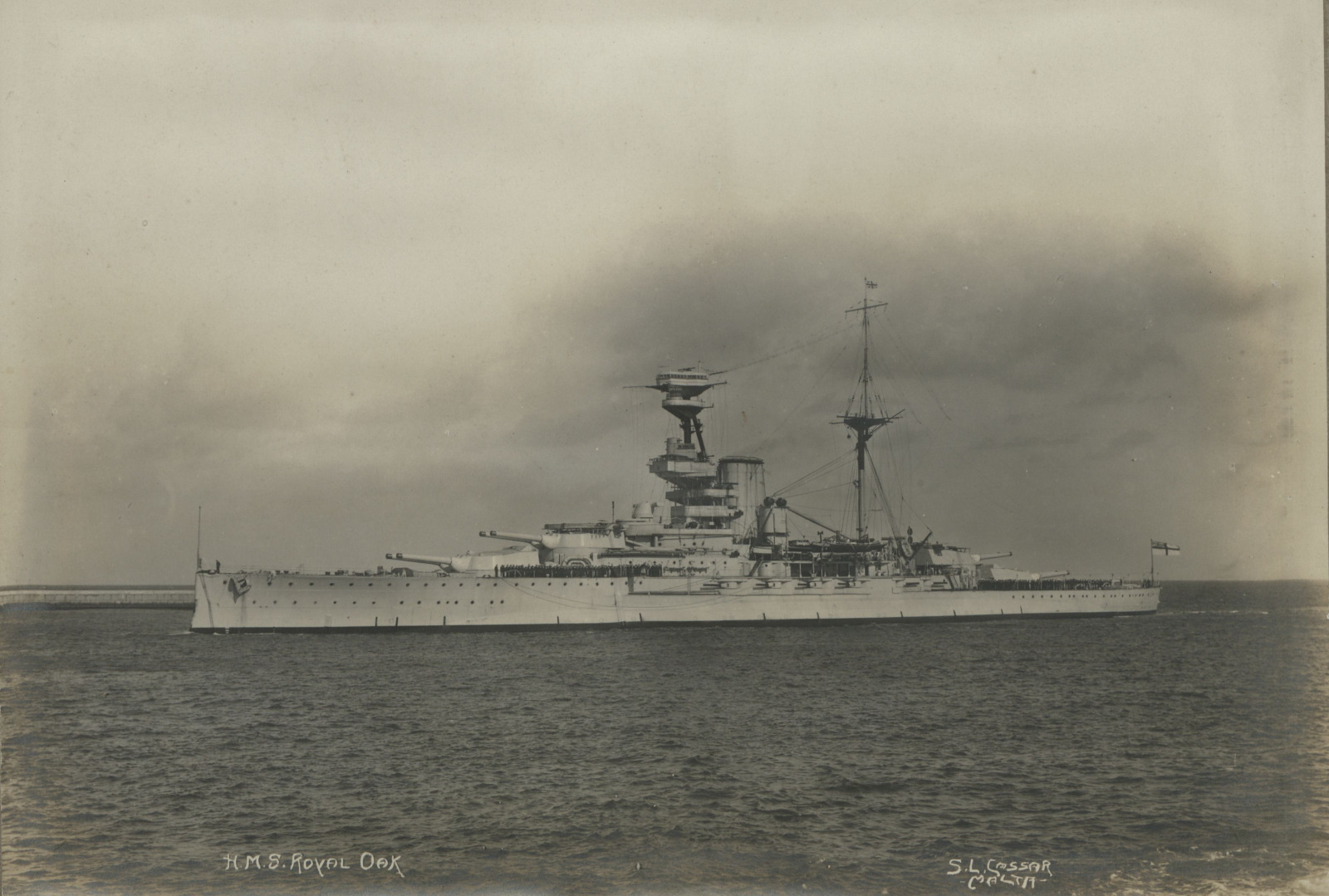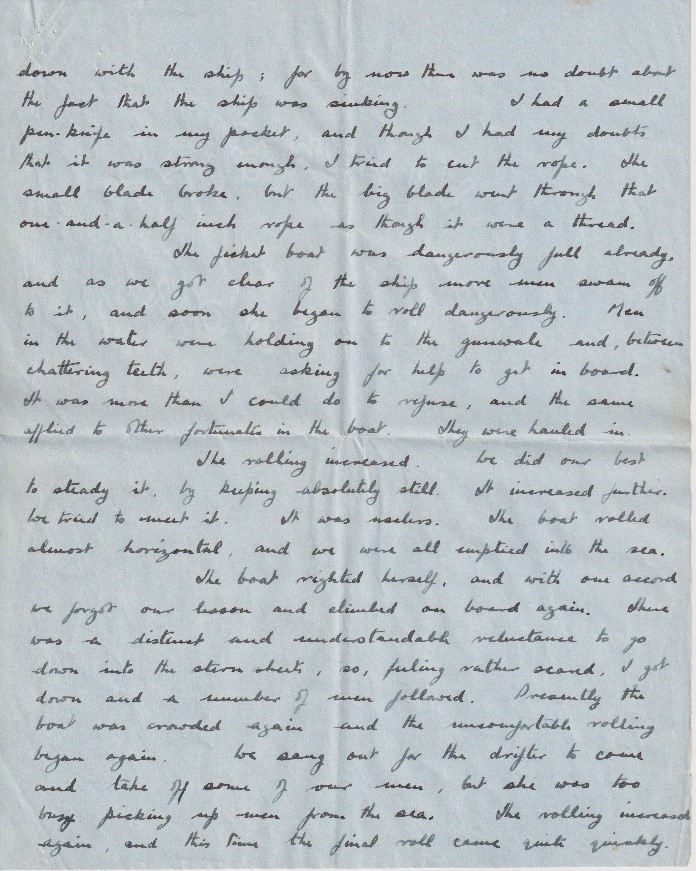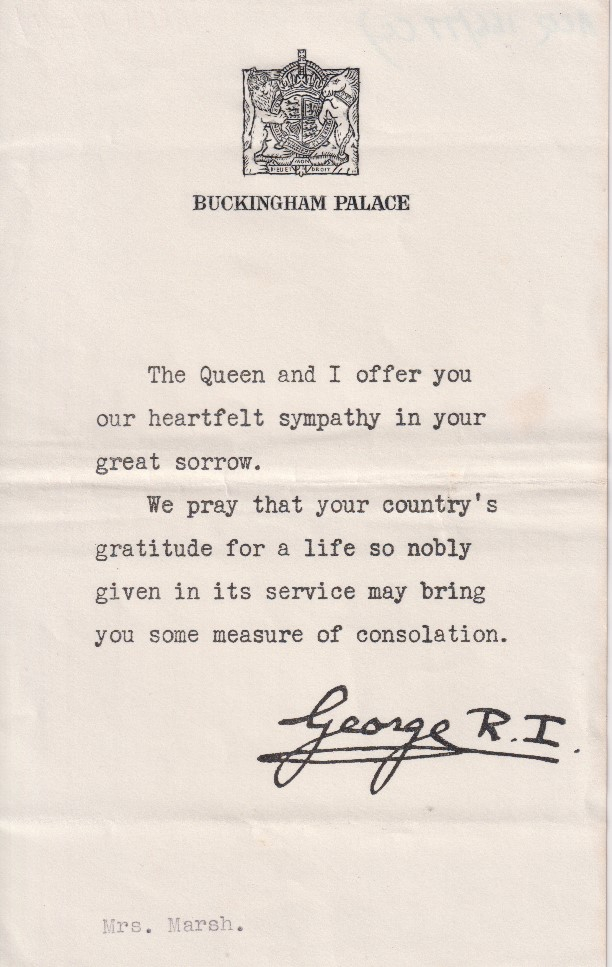The Sinking of HMS Royal Oak
- View news filtered by: Second World War
- View news filtered by: War and Peace
- View news filtered by: Battles
- View news filtered by type: Blog

The sinking of HMS Royal Oak, in the early days of the Second World War, was a major shock for the Royal Navy. In total 834 personnel were killed as a result of the successful torpedo strikes by German submarine U-47. Using the collection of the National Museum of the Royal Navy we can uncover the story of her sinking through the eyes of two people who survived.
What was HMS Royal Oak?
HMS Royal Oak was built and launched at Devonport in 1914. The ship had a crew of 1,000 men. During the First World War she took part in the Battle of Jutland (31 May to 1 June 1916), which was the largest naval battle of the war. During the 1930s she underwent several modernisation refits increasing the ships armour but reducing her speed. By the start of the Second World War HMS Royal Oak was no longer the pride of the Royal Navy. The ship was stationed at Scapa Flow in the island of Orkney. In October 1939 HMS Royal Oak was a part of an attempt by the Royal Navy to find the German ship Gneisenau, but was lagging behind unable to keep up with the rest of the fleet. The fleet soon dispersed to safer ports because of fears of aerial attacks, but HMS Royal Oak remained behind at Scapa Flow.

The sinking through the eyes of two survivors
On the night of 14 October 1939, the German submarine U-47 snuck past the defences of Scapa Flow. Soon they sighted HMS Royal Oak and at 12:58am launched torpedoes. While several torpedoes missed, one hit its target.
Royal Marine Horace Baber was asleep and was startled awake by the explosion. But soon the all clear was given and he fell back to sleep. Another member of the crew, Paymaster Lieutenant-Commander Eardley Maclean, had been awake gambling with a Lieutenant. He had been taking some air watching the Northern Lights when he heard the explosion. He feared it had been an explosion from the inflammable materials store, and went to investigate. Whilst investigating the store three more explosions were heard.
At 1:16am U-47 launched three torpedoes, with all three hitting the ship in quick succession. Baber was woken up to the explosions. He noticed that the ship began to list (tip) onto the ship’s starboard side. Baber got up and started to walk before stopping near an armoured door. Suddenly, he was lifted off the ground by another explosion. Flames spread across the Royal Marines Mess deck. Although injured he and three others escaped the flame and smoke-filled mess, but their escape was blocked by a locked door which could only be opened from the other side. As water started to pour in from nearby portholes, they attempted to smash it open but to no avail. Eventually, aided by people on the other side, they managed to crack open the door enough to get through. Together they all queued at the bottom of a ladder before managing to get to the upper deck.
Once on the upper deck it was ‘all chaos and confusion’. Jumping into the freezing water, Baber decided not to swim towards the shore as he thought it too far away, and instead swam around hoping to be picked up by a rescue vessel. In his account he writes:
"I looked back at the ship that twenty minutes before had been our home, now a mass of torn decks and plates sinking on her last journey. It was an awe inspiring sight a big mass of steel heeling over, with white flecked waves which seemed to be biting eagerly at their victim."
Rescue at Sea
Baber and his crewmates were stranded and began shouting for help, but eventually a trawler heard them and they were rescued. The trawler, packed full of survivors, was taken to a nearby ship. This trawler could have been the tender HMS Daisy II which on that night rescued 386 people.
Meanwhile, Maclean had managed to climb up onto the upper deck. He saw one of the ship’s boats in the water nearby, and along with others managed to slide down the side of the ship into the boat. They began to help others out the water too. However, the boat quickly became overloaded, with even more men clinging to the side with chattering teeth asking to be lifted aboard. Eventually the boat capsized throwing them all into the water, and even after it was righted it capsized a second time due to the amount of people trying to climb aboard.
When Maclean entered the water his mouth became full of oil that was flowing from the ship. ‘The rest of the swim was a nightmare’ he said. He felt as though he had been in the water for over an hour, struggling to keep his head above water. Eventually Maclean was found in the water and rescued. ‘I was utterly done. I was so cold that I could do nothing but shiver’. He was taken to HMS Pegasus where he was offered brandy, which he didn’t drink, a warm bath and a blanket.

Aftermath
The sinking of HMS Royal Oak sent shockwaves through the Royal Navy. It was the first battleship lost during the Second World War. While approximately 450 members of HMS Royal Oak’s crew survived, not all of those onboard were so fortunate. Of the over 1,000 strong crew around 834 died. This included 100 boy seamen, who were under the age of 18 undergoing Royal Navy training.

A few days later those that had survived were taken further south away from danger. Their deaths are commemorated annually at the wreck site by the placing of an ensign under her stern. The wreck is now a designated war grave, protecting the wreck and those who lost their lives.
You can find out more about the history of HMS Royal Oak's sinking and other items relating to the ship by visiting our Collections Portal.
Visit the Collections PortalThe National Museum of the Royal Navy is home to the history of our naval fleet, from inception to modern day. You can find other Royal Naval stories, such as our blog series charting the British Special Service Squadron on its centenary and a video looking at the role of the courageous Coastal Forces on our website or our YouTube channel.
Further Reading
HMS Royal Oak Association. Retrieved 27 September 2024.
Naval-History.net, HMS Royal Oak. Retrieved 27 September 2024.
Letter of sympathy, relating to the death of Mne J W Marsh in HMS Royal Oak, from King George VI and Queen Elizabeth.
Letter from Eardley Maclean. 4 November 1939.
An experience of the torpedoing of HMS Royal Oak. Horace Baber.
Sarkar, Dilip. The Sinking of HMS Royal Oak: In the Words of the Survivors. Amberley Publishing, 2012.
Snyder, Gerald S. The Royal Oak Disaster. William Kimber & Co Ltd, 1976.
Weaver, J. J. Nightmare at Scapa Flow: the truth about the sinking of HMS Royal Oak. Cressrelles, 1991.